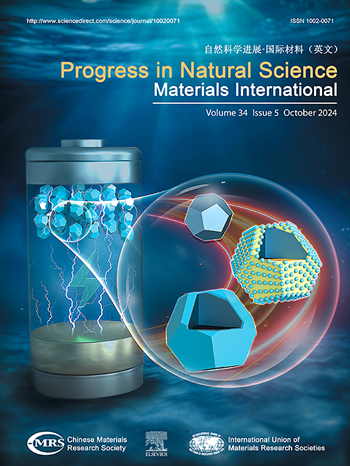A review of crystal defect-induced element segregation in multi-component alloy steels
IF 4.8
2区 材料科学
Q2 MATERIALS SCIENCE, MULTIDISCIPLINARY
Progress in Natural Science: Materials International
Pub Date : 2024-10-01
DOI:10.1016/j.pnsc.2024.07.016
引用次数: 0
Abstract
In multi-component alloy steels, the interplay of chemical interactions among elements and variations in atomic radius often results in element segregation towards defects, markedly influencing the macroscopic material properties. Despite many recent studies reporting defect-dependent element segregation in steel, a comprehensive overview is still lacking. In this work, element segregation at various defects and their influence on steel performance are examined. It specifically delves into the influences of element segregation at dislocation, grain boundary, phase boundary, and precipitate phase interface on the mechanical performance of steel. For each type of crystal defect-induced element segregation, this review discusses the crystallographic structure, segregated microstructure, element segregation distribution, and the corresponding influence of element segregation on the mechanical performance of steel. Finally, this review extensively explores the scientific issues and challenges of element segregation research in steel. It provides valuable insights into the behavior of element segregation in steel and inspires new research directions in other multi-component alloys.
多成分合金钢中晶体缺陷诱发的元素偏析综述
在多组分合金钢中,元素间化学作用的相互作用和原子半径的变化往往会导致元素向缺陷偏析,从而明显影响材料的宏观特性。尽管最近有许多研究报告了钢中依赖于缺陷的元素偏析,但仍然缺乏全面的概述。本研究探讨了各种缺陷处的元素偏析及其对钢材性能的影响。它特别研究了位错、晶界、相界和析出相界面处的元素偏析对钢机械性能的影响。针对每种晶体缺陷引起的元素偏析,本综述讨论了晶体结构、偏析微观结构、元素偏析分布以及元素偏析对钢机械性能的相应影响。最后,本综述广泛探讨了钢中元素偏析研究的科学问题和挑战。它为钢铁中的元素偏析行为提供了有价值的见解,并启发了其他多组分合金的新研究方向。
本文章由计算机程序翻译,如有差异,请以英文原文为准。
求助全文
约1分钟内获得全文
求助全文
来源期刊
CiteScore
8.60
自引率
2.10%
发文量
2812
审稿时长
49 days
期刊介绍:
Progress in Natural Science: Materials International provides scientists and engineers throughout the world with a central vehicle for the exchange and dissemination of basic theoretical studies and applied research of advanced materials. The emphasis is placed on original research, both analytical and experimental, which is of permanent interest to engineers and scientists, covering all aspects of new materials and technologies, such as, energy and environmental materials; advanced structural materials; advanced transportation materials, functional and electronic materials; nano-scale and amorphous materials; health and biological materials; materials modeling and simulation; materials characterization; and so on. The latest research achievements and innovative papers in basic theoretical studies and applied research of material science will be carefully selected and promptly reported. Thus, the aim of this Journal is to serve the global materials science and technology community with the latest research findings.
As a service to readers, an international bibliography of recent publications in advanced materials is published bimonthly.

 求助内容:
求助内容: 应助结果提醒方式:
应助结果提醒方式:


